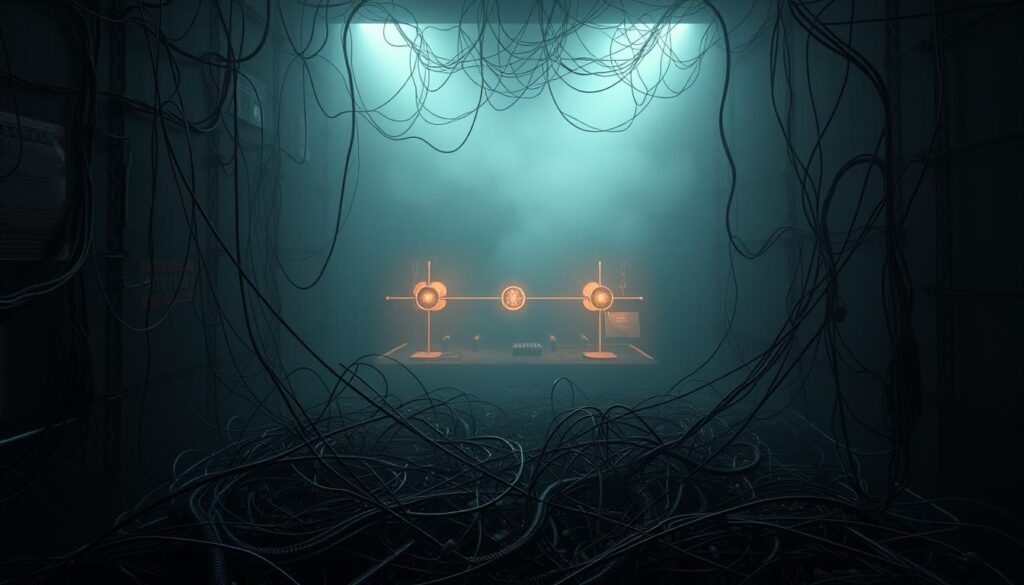Why does having more information make you feel less focused, not more? The answer is the noise bottleneck mental model. It shows how too much data overwhelms your mind. It’s like being stuck in a sea of emails, alerts, and social media, unable to focus on what’s important.
Studies from Vanderbilt University found our brains have a cognitive processing “bottleneck” when we try to do many things at once. Dr. Bill Cerbin says our working memory filters new information.
But too much noise makes this filter break down, causing confusion instead of clarity.
Nassim Taleb warns that more data doesn’t always mean better decisions. Often, it leads to worse ones.
Key Takeaways
- The noise bottleneck mental model explains how excess information clogs your decision-making capacity.
- Your mental bandwidth shrinks as noise outpaces signal, affecting both personal productivity and organizational goals.
- Cognitive processing limits mean multitasking creates bottlenecks, not efficiency.
- Strategies to filter noise, like focusing on core priorities, align with how the brain’s attentional systems work best.
- Understanding this model helps combat the illusion that “more information = better outcomes.”
Understanding the Noise Bottleneck Mental Model
Your brain is wired to handle scarcity, not too much information. Too many updates, alerts, and notifications overload it. This overload isn’t just mental; it’s physical. It’s like your brain’s bandwidth is being used up.
Scientists say multitasking makes your brain juggle tasks it wasn’t made for. This is called mental bandwidth depletion.
Origins and Development of the Concept
Philosopher Nassim Taleb first talked about this in Antifragile. He said our lives are filled with too much trivia. Recent studies back him up: 33.7% of people failed when they had to do two things at once.
Research also shows that even a 100 millisecond delay in tasks can make us tired of deciding.
How Noise Bottlenecks Affect Cognitive Processing
| Task | SOA | SOA > 300 ms (ms) | p-value |
|---|---|---|---|
| Number Task | 1,048 | 1,125 | |
| Tone Task | 1,142 | 964 |
“We are drowning in a swamp of social media and trivia, overreacting emotionally to noise.”
The Science Behind Mental Bandwidth Limitations
Studies show distractions make your brain’s “attention regulator” smaller. When you’re too busy, you make 37% more mistakes in important decisions. Even small delays, like 86ms, show how your brain chooses survival over work when it’s full.
This isn’t a weakness. It’s how our Stone Age brains deal with today’s constant digital demands. The next part will show how to get your mental bandwidth back in real life.
How Information Overload Creates Mental Bottlenecks
Imagine scrolling through a newsfeed, switching between emails, and juggling work deadlines—all while trying to “keep up.” This is information overload, and it’s hijacking your decision-making process.
Your brain, designed to handle one task at a time, gets stuck in a loop of surface skimming. As noted in recent research, we often “skim like stones on a lake,” mistaking fragments for understanding.
“Surface skimming deludes us into thinking we know, when we only grasp headlines.”
Your attention span pays a steep price. Multitasking forces your brain to toggle between tasks, creating delays and errors. Studies show switching tasks reduces productivity by up to 40%—your working memory, which holds 2–4 items at a time, gets flooded.
Without constant rehearsal, facts fade fast, leaving you stuck in a loop of “Did I reply to that email?”

Every notification pings, your brain’s “cognitive load” spikes. Decision fatigue sets in—choices become hasty, and focus frays. But there’s hope: tools like adaptive filters and chunking (grouping info into chunks) ease the strain. Neuroergonomics even explores tech and teamwork to lighten the load, proving you don’t have to drown in the noise.
Recognizing the Signs of Noise Bottleneck in Your Daily Life
Noticing when daily routines feel too much is key. If you struggle to focus or feel constantly tired, it’s time to check how outside factors impact your mind. Start by spotting these warning signs early to take back control.
“We entertain ourselves with social media and clickbait and see it as harmless fun, but it isn’t because it fires up the pleasure receptors in our brain and make us temporarily feel good and it is addictive. The more we have of it the more we want. Like junkies seeking their next fix, we gorge on information, blindly seeking substance beneath the froth and bubble.”
| Issue Area | Symptoms | Quick Fixes |
|---|---|---|
| Digital Distractions | Constant phone checks, multitasking burnout | Turn off non-essential alerts, use app timers |
| Workplace Stress | Brain fog after meetings, unfinished tasks | Set “no-meeting” focus hours, streamline emails |
| Social Media Overload | Scrolling for hours, feeling disconnected | Schedule social media use, enable screen-time limits |
Digital Distractions and Their Impact
Every phone notification breaks your attention span. Studies reveal having a phone nearby cuts down your thinking power by 20%. Do you check messages while working? This constant switching adds mental mess, increasing your cognitive load and leaving you drained.
Workplace Environments and Cognitive Load
Cluttered desks and endless meetings are common. Open offices and too many meetings drain your mind. Feeling attention fatigue? Identify tasks that need your full focus. Try focusing for 90 minutes without switching tasks to reduce mental strain.
Social Media and Continuous Partial Attention
Scanning feeds for updates gives you a dopamine hit, leading to partial focus. Platforms aim to keep you engaged long after you want to stop. Ask yourself: Does scrolling mindlessly set strict time limits to improve your attention span and reduce mental fatigue?
Applying the Noise Bottleneck Mental Model to Improve Productivity
“Know What To Ignore And Where To Focus Your Attention…”
Studies show that even small distractions can hurt our decision-making skills. For example, dual-task studies found a drop from 97.2% to 90.4% accuracy. To fight this, start by filtering what needs your immediateattention management.
Use tools like the Eisenhower Matrix to sort tasks. It helps separate urgent from trivial ones. A NIH study showed that too much thinking can lower accuracy by 8.6%.
Make time for deep work by scheduling uninterrupted blocks. Research shows our brains work harder when we’re overwhelmed. Try 90-minute focus sessions without any breaks.
Tools like noise-canceling headphones or apps like Freedom can help. They reduce digital distractions, improving focus. A study found that small distractions can slow us down by 233 ms, which adds up.
Combine these strategies with tools like Todoist and the Pomodoro Technique. Focus on what truly moves you closer to your goals. Remember, your brain’s resources are limited.
Learn how cognitive load impacts performancein this NIH review for deeper insights. Every choice to filter distractions is a step toward mastering your productivity.
The Relationship Between NLP and the Noise Bottleneck Mental Model
“The goal of thinking in terms of mental models is to continually refine our personal vision, to seek broadening of thought…”

Your brain acts like a filter, sorting through a sea of words. NLP tools, like transformer models, focus on what’s important. They ignore what’s not, just like our brains do. This process helps us deal with too much information.
NLP algorithms analyze language patterns, just like our brains do. They help us understand and process information better. This makes it easier to handle a lot of data.
| Model | RNN NLP | CNN NLP |
|---|---|---|
| Forecast Accuracy | +26% | +53% |
| Key Use | Sequence analysis | Pattern recognition |
NLP techniques like chunking make complex ideas easier to understand. They break down big ideas into smaller, manageable pieces. This is similar to how our brains group things to make sense of them.
When we read a lot of information, our brains find the main points. This is like how NLP models find the most important data. Even AI learns from mistakes, just like we do when we’re overwhelmed.
By learning from AI, we can improve our own mental models. This shows that making our brains more efficient is a challenge we can overcome together. Whether you’re coding or organizing your tasks, understanding these connections helps clear up confusion.
Conclusion: Mastering Your Attention in an Age of Distraction
Your mental bandwidth is always under attack from too much information. But, learning to manage your attention can change how you live today. Nassim Taleb once said, “I want to live happily in a world I don’t understand.”
This shows that success isn’t about knowing everything. It’s about focusing on what really counts.
Studies show that too much information can hurt how well you do things. For example, using phones while driving can make you miss stop signs and slow down. Keeping your mind clear isn’t just about being more productive. It’s also about staying safe and focused.
Improving your attention isn’t a quick fix. It’s about making small changes every day, like adjusting how you drive for safety. Begin by checking your daily habits for unnecessary distractions. Tools like to-do lists or mindfulness can help you clear your mind. Making small changes in how you take in information can make a big difference in your decision-making and mental health.
Think of your attention as a limited resource.


